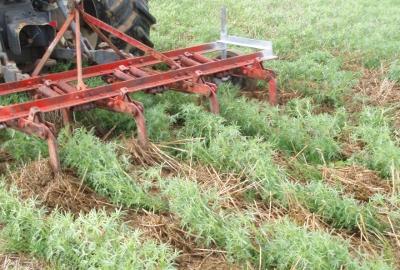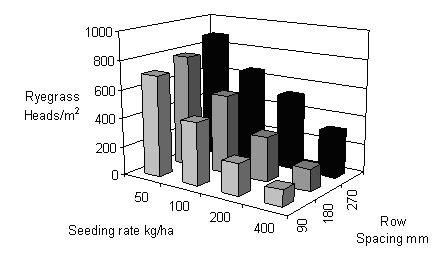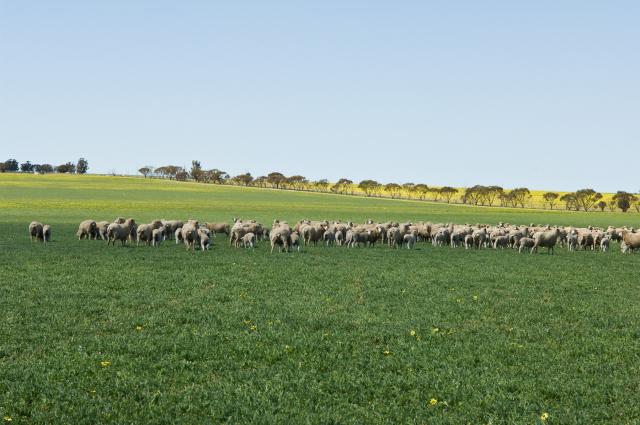Methods for killing weeds in target areas
This weed control tactic involves controlling weeds once they have germinated, either before the crop has been sown or when they are seedlings within the crop.
Cultivation
Fallow or pre-sowing cultivation can kill many weeds including herbicide resistant populations. Cultivation is useful as a ‘one-off’ tactic in reduced tillage or no-till operations, and can be used as a non-herbicide component of a ‘double knock’ system.
Herbicides
Herbicides continue to play a vital role in integrated weed management. Better knowledge of the mechanisms and activity of herbicides will improve the impact and sustainability of herbicides as a weed management tactic. Herbicides include non-selective, pre-emergent and selective post-emergent products.
Weed control in wide-row cropping
Wide row cropping allows targeted weed control within the crop, using non-selective herbicides, to overcome herbicide resistant wild radish and annual ryegrass populations. However, overuse of non-selective herbicides can lead to resistance in these products.
Spot spraying
Techniques like spot spraying, chipping, hand roguing and wiper technologies can be used to target new weed infestations where weeds occur in low numbers and localised eradication is possible. More information can be found at the Herbicide application page.
Biological control
Biological control is the management of weeds using the weed's natural enemies (biological control agents). There are three generally recognised types of biological control: ‘classical’, ‘inundative’ and ‘conservation’.
Cultivation - fallow and pre-sowing
Cultivation is useful as a 'one-off' tactic in reduced tillage or no-tillage operations, to achieve effective weed control. Over-reliance on cultivation can reduce surface stubble cover, increase erosion risk, degrade soil structure and reduce soil moisture retention. Poorly timed cultivation will result in a poor seedbed, leading to reduced crop emergence, herbicide damage and reduced herbicide performance.
Benefits
- Well timed cultivation effectively kills weeds through:
- plant burial
- seed burial, thus reducing the ability to germinate
- root severing
- plant desiccation, where plants are left on the soil surface to die
- breaking seed dormancy
- seed placed in a more favourable environment to encourage germination for subsequent control
- The impact of cultivation will depend on the weed species. Seed of annual ryegrass will more rapidly lose viability at deeper soil depths than when shallowly buried. By contrast, seed viability of other species (for example, wild radish and common sowthistle) increase with depth of burial.
- In preparing a seedbed, cultivation provides a weed-free environment for the emerging crop.
- Cultivation can control weeds in situations where herbicides are ineffective or not an option, that is, when weeds are too stressed to respond to herbicides (especially over the summer fallow), weeds are resistant to herbicides or herbicide sensitive crops are nearby.
- Pre-sowing cultivation or full disturbance cultivation at sowing reduces the reliance on knockdown herbicides and therefore the likelihood of weed populations developing herbicide resistance.
- Cultivation for weed management can be an additional benefit obtained when incorporating soil ameliorants (such as lime or gypsum) or breaking up a plough pan.
Issues to consider
- Strategic cultivation must take into account whole-farm practicalities. Avoid repeated cultivation – use it strategically in situations where no suitable alternatives are available. Cultivation can increase weed control costs through increased labour and machinery inputs.
- Maintain soil structure by cultivating at suitable soil moisture levels and appropriate implement ground speed. Cultivating when the soil is too wet can cause ‘smearing’ and compaction. On the other hand, cultivation when the soil is too dry can destroy soil structure. Both will lead to reduced water infiltration and storage, and soil aeration. Travelling faster than the recommended ground speed for a particular implement type will greatly increase the damage to soil structure.
- The tillage implement used will influence the level of soil disturbance and thereby the effect on the weeds present. A disc plough or mouldboard invert soil and bury weed seed. However, for those weeds species where burial prolongs the life of the seed bank, scarifiers and cultivators that cause little soil disturbance (operation at less than 10 centimetres (cm) depth) can be used to kill weeds and may simulate weed seed germination (for effective control once the weeds have emerged).
- Choice of cultivation practice can influence weed density and spectrum. For example, species like skeleton weed that reproduce vegetatively will be encouraged by cultivation, whereas weeds like fleabane or silver grass will be effectively controlled by cultivation and are encouraged by the reduced tillage system.
- Cultivation is most successful when used against small weeds (before flowering commences). Root systems of large weeds may be extensive, making removal difficult. Weeds that are not fully dislodged by the cultivation may re-root if the surface soil remains moist.
Herbicides for different situations
Herbicide tolerant crops
Herbicide tolerant crops have a tolerance to herbicides that normally would cause severe damage (for example, Group B imidazolinone in Clearfield® canola). Herbicide tolerant crops provide additional crop choice, enabling implementation of alternate weed management tactics to target specific weeds whilst maintaining crop sequences.
Herbicide tolerance traits are introduced into crops either by conventional breeding methods (and include triazine tolerant (TT) canola introduced in 1994 and imidazolinone tolerant (IT) wheat, introduced in 2001) or by genetic modification (GM), where genes are introduced from another organism. Genetically modified (GM) herbicide tolerant (HT) cotton has been commercially grown in Australia since 2000, while Roundup Ready® (RR) canola was first commercialised in some states in 2008.
For more information refer to Information on genetically modified (GM) crops and the Genetically modified crops and herbicide resistance.
Winter fallows
Winter fallows are becoming more popular in Western Australia especially in the drier areas. They are usually incorporated as a one-year rotation into cropping programs to reduce weeds and retain moisture profiles. A fallow period on its own, or in sequence with a number of crops, can be highly effective in reducing the weed seedbank (by utilising non-selective herbicide etcetera).
An alternative is a 10 month fallow. These suit either 100% cropping enterprises or those with stock where there is value in grazing early feed. In this system, the first spray is not applied until there is stem elongation and some woodiness. This achieves soil stabilisation and a mulch effect to reduce summer evaporation provided the fallow is not grazed afterwards. Growing canola after the fallow can increase the reliability of the canola and broaden the opportunity for good weed control.
Both fallow systems give an opportunity to do deep-ripping or liming on those paddocks while they are out of cropping and if weed numbers are kept low then crops can be dry sown the following season. It is important to have a zero seed set policy for fallows to achieve this objective.
Controlled traffic or tramlining for optimal herbicide application
Controlled traffic or tramlining refers to a cropping system designed to limit soil damage by confining all wheel traffic to permanent lanes for all field operations, including seeding, harvesting and all spraying activities.
A traffic lane can increase the health of the crop due to improved soil characteristics which in turn can improve the competitive ability of the crop. They can also provide guidance and a firmer pathway for more timely and accurate application of herbicide. This will help to improve weed control and reduce input costs.
For more information refer to Developing a controlled traffic (tramline) farming system.
Weed detector sprayers
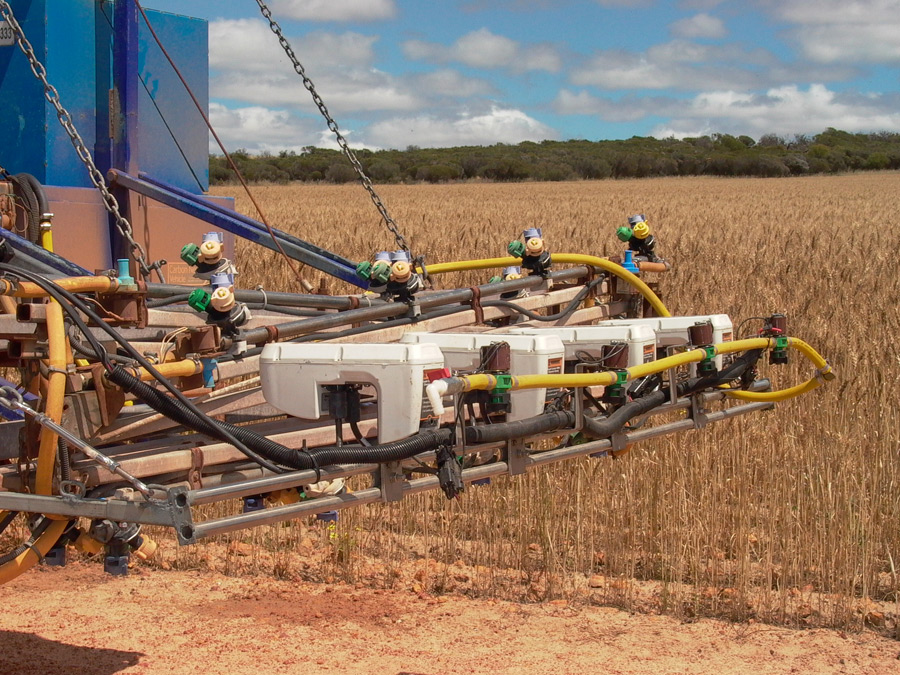
Weed detector sprayers are for the control of scattered weeds in crop fallows. Weed detector-activated sprayers detect the presence of weeds using infra-red reflectance units linked to a single nozzle. When a weed is detected, a solenoid turns on an individual nozzle and the weed is sprayed. In action, light-emitting diodes (LEDs) point two different light sources, infrared and near infrared, towards the ground. Green weeds have a different reflective signature to stubble or soil. The system can operate at speeds up to 20 kilometres per hour (km/h), requiring a stable boom to aid operational efficiency.
One advantage is a lower risk of drift as coarse droplets are used and only a low percent of the paddock is sprayed.
Grower experience using this technology has been that in most summer spraying and winter fallow situations, less than 10% of the entire paddock is sprayed. For greener paddocks, with more ground cover from weeds, it is often more economical to blanket spray the entire paddock given the low glyphosate prices at present.
Weed control in wide-row cropping
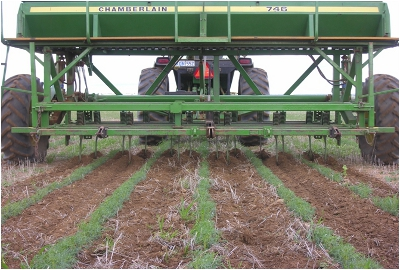
Widening the row spacings allows different methods of weed control to be employed, such as selective chemicals in the on-row zone and non-selective chemical, physical or mechanical methods in the inter-row zone.
Wide-row cropping in Western Australia
Wide-row cropping has been used in Western Australia as a strategy to overcome herbicide resistant wild radish and, to a lesser extent, annual ryegrass, particularly in pulse crops
This tactic uses non-selective (knockdown) herbicides to control weeds in the inter-row space of the crop. In some circumstances inter-row cultivation may be applicable. Band spraying over the crop row allows selective herbicides to control weeds that the shielded sprayer or inter-row cultivation techniques cannot reach. In addition, band spraying effectively reduces the total amount of herbicide used on a per hectare basis, which in turn reduces costs and minimises the potential for herbicide carryover.
Glossary
- Wide rows – crop rows which are 50cm and wider
- Inter-row – the strip of soil between the crop rows
- Crop-row – the strip of soil taken up by the crop
- Shielded spraying – the practice in which shields are used to protect the crop-rows while weeds in the inter-row area are sprayed with a non-selective herbicide
- Band spraying – the practice in which a given area (band) of selective herbicide is applied to weeds in either the crop-row or inter-row only
- Inter-row cultivation – the practice in which weeds in the inter-row space are controlled using tillage equipment). Please note that where retained stubble is dense, it may not be physically possible to carry out inter-row cultivation. Also, inter-row cultivation can stimulate emergence of some weed species.
Inter-row shielded spraying and crop-row band spraying
Keep in mind that the trend towards wide-row planting for a range of crops risks greater reliance on herbicide control to balance declining crop competition. This poses serious problems for the development and management of herbicide resistant weeds.
Issues to consider:
- Shielded spraying allows inter-row application of non-selective herbicides in-crop, which can increase crop yield.
- Band spraying reduces the risk of herbicide resistance development by limiting the application of higher risk selective herbicides over the crop row.
- Herbicide mode of action groups need to be rotated.
- Timing of shielded spraying is important.
- Care must be taken with the set-up and operation of shielded sprayers to minimise spray drift. All shields leak spray drift to some extent.
Inter-row cultivation
Issues to consider:
- Inter-row cultivation gives the opportunity to control weeds without herbicides.
- Timing of inter-row cultivation is critical to ensure maximum levels of weed control. Best control is achieved when the weeds are small.
- Weed control is reduced if the soil is too wet, as the weeds will transplant.
- Heavy stubble cover may preclude the use of inter-row cultivation.
- Inter-row cultivation does not control weeds in the crop row, so an additional tactic must be used for the crop-row weeds.
- Inter-row cultivation cannot be used in conjunction with ground covering stubble mulch techniques, as cultivation reduces the opportunity to maintain the mulch.
- Inter-row cultivation can stimulate emergence of some weed species.
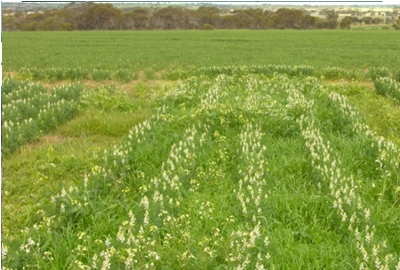
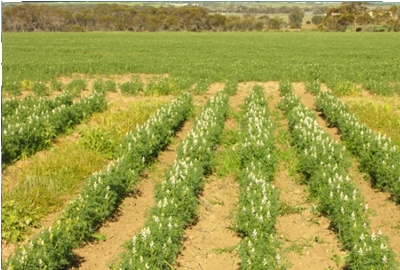
Agronomy options to enhance the impacts of weed management
Some agronomic practices can improve crop environment and growth, along with the crop's ability to compete with weeds. These include crop choice and sequence, improving crop competition and improving pasture competition.
Crop choice and sequence
The ability to compete with weeds varies between crop type and variety. In paddocks with lots of weeds, a competitive crop can reduce weed seed-set and reduce the impact the weed has on crop yield.
Generally cereal crops are more competitive with oats ranked the highest, then barley then wheat.
Plan crop rotations in advance to minimise disease and insect problems and maximise crop fertility. If these are managed optimally, crops then become more competitive against weeds. Some weed management tactics rely on specific crop type and variety, or the sequence of cropping.
Improving crop competition
The impact of weeds on crop yield can be reduced and the effectiveness of weed control tactics increased by improving crop competition. The rate and extent of crop canopy development are key factors influencing a crop’s competitive ability with weeds. A crop that rapidly establishes a vigorous canopy, intercepting maximum sunlight and shading the ground and inter-row area, will provide optimum levels of competition.
Canopy development can be influenced by:
- Crop and variety: Oats are the most competitive against annual ryegrass, whilst chickpeas and lupins have shown limited ability to compete against weeds.
- Row spacing, sowing rate and sowing depth: Increasing sowing rate can result in earlier crop canopy closure and greater dry matter production, resulting in improved weed suppression. Narrow crop rows usually deliver much better crop competition than wider rows. Maximum competitive ability will come from a crop sown at optimum and uniform depth to get rapid and uniform establishment.
- Crop row orientation: The competitive ability of cereal crops can be increased by orientating crop rows at a right angle to the sun light direction, that is, sow crops in an east-west direction. East-west orientation more effectively shade weeds in the inter-row space than north-south crops. The shaded weeds have reduced biomass production and reduced seed set. In particularly weedy fields, the reduced weed growth leads to increased crop yield.
- Crop nutrition and disease: A healthy crop will best compete with weeds
- Environmental conditions including soil properties and rainfall: Matching the crop (and variety) to the soil type can improve crop vigour and biomass production, which in turn will optimise crop competitive ability. Time of sowing also has a direct impact on the competitive ability of a crop. Delaying sowing beyond the optimum window recommended in a given district will reduce early vigour, extend the time taken to reach canopy closure and reduce overall dry matter production.
This figure shows the seed rate and row spacing effects of wheat (cv. Arrino) on weed growth. High seed rates and narrow row spacing has significantly suppressed ryegrass growth. [Minkey, Reithmuller and Hashem (1999)]
Improving pasture competition
Pastures represent an important component of many rotations, and normally take 1–5 years to break up extended periods of cropping. Incorporating pastures can help restore soil fertility (organic matter and soil nitrogen) that may have declined due to frequent cropping, and in turn improve the competitive ability of crops.
Pastures provide a valuable opportunity to manage weed problems using tactics not able to be used in cropping situations, such as grazing, mechanical manipulation and non-selective herbicides. Change the timing of these tactics to fit into vulnerable stages of the weed life cycle, for example:
- Time the grazing pressure to manipulate pasture composition. For more information refer to Pasture manipulation for grass control.
- Spray-graze, where grazing is used in conjunction with herbicides. This is a technique for the control of broad-leaved weeds (often capeweed) in pasture and relies on the winter application of sub-lethal rate of herbicides (usually MCPA) to induce plants to wilt. This increases their palatability and animals (at a high stocking rate, seven days after spraying) graze them in preference to clovers and grasses which are not affected by the herbicide. It is important that the treated pasture has a good legume base to compete with the weeds and provide stock feed when the weeds are killed and that they are grazed heavily after spraying so the weeds do not recover. Spray-grazing needs to be repeated each year until the dormant weed seed is exhausted. Note that spray-grazing cannot be used in a medic pasture. For more information refer to Spray grazing - for broadleaf weed control in pastures.
- Exploit the differences in species acceptability to sheep, for example, grasses are more palatable in autumn
Biological control of weeds
Biological control is the management of weeds using the weed's natural enemies (biological control agents). The mode of action of a biological control agent is either to feed on the weeds (insects) or cause disease in the weeds (pathogens). This in turn slows growth, reduces seed-set and/or eventually leads to the death of the weed. There are three generally recognised types of biological control: ‘classical’, ‘inundative’ and ‘conservation’.
Patterson's curse is partially controlled by insects like the crown weevil.
Types of biological control
Classical control
Classical control is the most commonly used and widely known approach. It involves:
- Exploration for natural enemies of the host weed in the plant's region of origin.
- Rigorous host testing of potential control agents.
- Importation and clearing through quarantine.
- Approval followed by release onto the target weed in Australia.
Inundative control
The inundative approach involves mass production of biological control agents and then mass release of them in order to produce an epidemic against the weed. The inundative approach is best illustrated by the development of bioherbicides. Bioherbicides have an advantage over chemical herbicides in situations where the latter may be ineffective (for example, due to herbicide resistance) or inappropriate (for example, near sensitive wetlands or in organic agriculture). Although bioherbicides have been researched in Australia, they have not been brought to commercial use due to the constraints of production costs and limited markets.
Conservation biological control
Conservation biological control involves managing both the crop and the weed to favour the presence of naturally occurring biological control agents that attack the weed.
Benefits
- About 33% of biological control agents have resulted in substantial control of the target weeds. Biological control success can range from complete (no other weed control required), to substantial (other weed control methods are needed but the effort required has been reduced) to negligible (control is still dependent on other control measures).
- When classical biological control is successful it is very cost-effective.
- The recognised potential of bioherbicides as an effective form of weed control stimulates future investigation.
Issues to consider
- Weed biology factors influence biological control efficacy. Not all weeds are suitable for biological control.
- Survival of the control agent relies on survival of the weed.
- The success of biological control is dependent on the existence of suitable agents and their degree of host specificity. It is difficult to find biological control agents for weeds that are closely related to crops (for example, wild oats).
- Bioherbicide technology is limited in terms of the cost of production. The Australian market is generally too small to warrant bioherbicide development.





